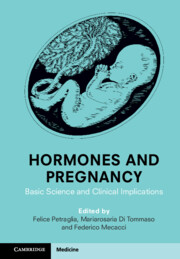Book contents
- Hormones and Pregnancy
- Hormones and Pregnancy
- Copyright page
- Contents
- Contributors
- Section I Hormones in the Physiology and Pharmacology of Pregnancy
- Chapter 1 The Neuroendocrinology of Pregnancy
- Chapter 2 The Placenta as an Endocrine Organ/Placental Endocrinology
- Chapter 3 The Role of Oxytocin in Pregnancy
- Chapter 4 The Role of Human Chorionic Gonadotropin in Pregnancy
- Chapter 5 The Role of Estrogens in Pregnancy
- Chapter 6 The Role of Progesterone in Pregnancy
- Chapter 7 Hormones and Cardiovascular Systems in Pregnancy
- Section II Hormones and Gestational Disorders
- Index
- References
Chapter 3 - The Role of Oxytocin in Pregnancy
from Section I - Hormones in the Physiology and Pharmacology of Pregnancy
Published online by Cambridge University Press: 09 November 2022
- Hormones and Pregnancy
- Hormones and Pregnancy
- Copyright page
- Contents
- Contributors
- Section I Hormones in the Physiology and Pharmacology of Pregnancy
- Chapter 1 The Neuroendocrinology of Pregnancy
- Chapter 2 The Placenta as an Endocrine Organ/Placental Endocrinology
- Chapter 3 The Role of Oxytocin in Pregnancy
- Chapter 4 The Role of Human Chorionic Gonadotropin in Pregnancy
- Chapter 5 The Role of Estrogens in Pregnancy
- Chapter 6 The Role of Progesterone in Pregnancy
- Chapter 7 Hormones and Cardiovascular Systems in Pregnancy
- Section II Hormones and Gestational Disorders
- Index
- References
Summary
The small peptide hormone oxytocin is produced as part of a larger precursor protein in the magnocellular neurones of the hypothalamus, whence it is transported down axons to the posterior pituitary to be released in a pulsatile manner upon nervous stimulation. Pituitary oxytocin is involved in contractility of the male and female tracts during intercourse and the transport of gametes to the site of fertilization. In early pregnancy, oxytocin action on myometrial smooth muscle is suppressed until pre-term, when increasing pulsatility, together with increased uterine oxytocin receptor expression, as well as declining suppressive factors, lead to a positive feedback situation and expulsion of the fetus at term. Postpartum, oxytocin is responsible for the milk let-down reflex enabling breast-feeding and ensures the birth of the placenta and subsequent anti-hemorrhagic involution of the uterus. Within the brain, oxytocin induces positive mood and maternal behavior, and may be involved with feeding and satiety. Pharmacologically, oxytocin is used to promote labor; and specific antagonists may delay pre-term contractions or facilitate embryo implantation.
- Type
- Chapter
- Information
- Hormones and PregnancyBasic Science and Clinical Implications, pp. 20 - 32Publisher: Cambridge University PressPrint publication year: 2022

